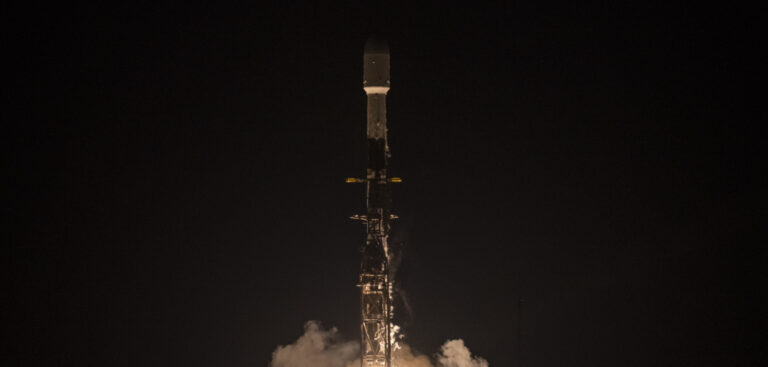A SpaceX rocket carrying a satellite designed to observe nearly all the water on Earth’s surface has successfully launched from Vandenberg Space Force Base in California.
An international collaboration between US space agency NASA and French space agency Centre National d’Études Spatiales (CNES), with contributions from the Canadian Space Agency (CSA) and the UK Space Agency, the Surface Water and Ocean Topography (SWOT) satellite will measure the height of water in freshwater bodies and the ocean on more than 90% of Earth’s surface.
Over the next three years, this information will provide insights into how the ocean influences climate change; how a warming world affects lakes, rivers and reservoirs; and how communities can better prepare for disasters such as floods.
SWOT launched and separated from the second stage of a SpaceX Falcon 9 rocket on December 16, and will now undergo a series of checks and calibrations before it starts collecting scientific data in around six months.
Bill Nelson, NASA Administrator, said, “Warming seas, extreme weather, more severe wildfires – these are only some of the consequences humanity is facing due to climate change. The climate crisis requires an all-hands-on-deck approach, and SWOT is the realization of a long-standing international partnership that will ultimately better equip communities so that they can face these challenges.”
SWOT will cover the entire Earth surface between 78° south and 78° north latitude at least once every 21 days, sending back about one terabyte of unprocessed data per day. The scientific heart of the spacecraft is an innovative instrument called the Ka-band radar interferometer (KaRIn), which marks a major technological advancement. KaRIn bounces radar pulses off the water’s surface and receives the return signal using two antennas on either side of the spacecraft. This arrangement – one signal, two antennas – will enable engineers to precisely determine the height of the water’s surface across two swaths at a time, each of them 50km wide.
Karen St. Germain, NASA Earth science division director, said, “We’re eager to see SWOT in action. This satellite embodies how we are improving life on Earth through science and technological innovations. The data that innovation will provide is essential to better understanding of how Earth’s air, water and ecosystems interact – and how people can thrive on our changing planet.”
Among the many benefits the SWOT mission will provide is a significantly clearer picture of Earth’s freshwater bodies. It will provide data on more than 95% of the world’s lakes larger than 62,500m2 and rivers wider than 100m across. Currently, freshwater researchers have reliable measurements for only a few thousand lakes around the world. SWOT will push that number into the millions.
Along the coast, SWOT will provide information on sea level, filling in observational gaps in areas that don’t have tide gauges or other instruments that measure sea surface height. Over time, that data can help researchers better track sea-level rise, which will directly affect communities and coastal ecosystems.
Caroline Laurent, CNES orbital systems and applications director, said, “This mission marks the continuity of 30 years of collaboration between NASA and CNES in altimetry. It shows how international collaboration can be achieved through a breakthrough mission that will help us better understand climate change and its effects around the world.”
SWOT measurements will also help researchers, policymakers and resource managers better assess and plan for disasters, including floods and droughts. By providing information on where the water is – where it’s coming from and where it’s going – researchers can improve flood projections for rivers and monitor drought effects on lakes and reservoirs.
The UK Space Agency provided UK technology company Honeywell with £12.2m (US$15m) to develop KaRIn’s Ka-band duplexer. UK scientists will also support the international effort to assess and exploit SWOT data over areas with very high tidal ranges and fast currents. The UK Space Agency partnered with the Natural Environment Research Council (NERC), between them investing £375,000 (US$460,000) in the SWOT-UK science research project that will focus on SWOT data covering the Bristol Channel and Severn Estuary area.
Professor Christine Gommenginger, principal scientist in satellite oceanography at the UK’s National Oceanography Centre (NOC), said, “For the first time, SWOT will produce detailed images of water levels that will help understand the complex processes that connect water levels over the ocean and inland waters. One objective of SWOT-UK is to demonstrate how satellite Earth observation data can be used with in-situ instruments and numerical models to answer important questions for science and society.”
Dr Paul Bate, CEO of the UK Space Agency, said, “SWOT will revolutionize our understanding of our planet’s surface water and how its patterns are changing, giving us vital information to improve how we manage one of humanity’s most precious resources. This is an important mission for the UK to be involved in, both in terms of building the radar instrument and in directly receiving and analyzing Earth observation data for the UK. I look forward to seeing the data that the satellite returns on the Bristol Channel and Severn Estuary.”



